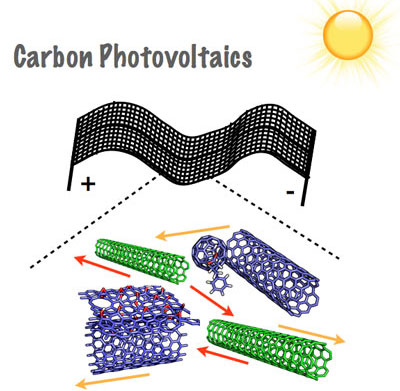| Posted: Sep 27, 2012 | |
All-carbon solar cells |
|
| (Nanowerk Spotlight) It was previously thought that carbon nanotubes and other carbon nanomaterials are not well suited to make efficient solar cells. The main reason for this is that nanotubes are hard to isolate in single chiralities or in a given diameter range and only of semiconducting or metallic type, and thus it is hard to use them in a controlled way. Similar considerations hold for other families of carbon nanomaterials although advances in graphene processing have already opened the door to using graphene sheets as light absorbers in photovoltaics (read more: "Solar cells made of carbon only are becoming a possibility"). By and large, though, the potential of carbon as the active layer material in photovoltaics is still unexplored. | |
| New work, published in the September 6, 2012 online edition of ACS Nano ("Nanocarbon-Based Photovoltaics") has now shown that thin film solar cells made entirely out of carbon nanomaterials can achieve an efficiency similar to that of polymer solar cells at their initial research stages (a decade ago), but with much improved photostability a key issue for polymers and other solar cells deposited from solution (read more on this degradation issue: "Nanotechnology packaging improves lifetime of organic solar cells"). | |
| "The use of carbon materials holds great promise towards the realization of photostable (namely, durable) thin film solar cells; the device shown in our work is the first efficient device of this kind, but there is large room for optimization," Marco Bernardi, a graduate student in Jeffrey Grossman's group at MIT, and first author of the paper, tells Nanowerk. "The cells' active layer is only 100 nm thick versus 1-100 µm for conventional solar cells. In addition, the cells can be deposited from solution and thus retain all the manufacturing advantages of polymer-based solar cells, yet with higher absorption, transport properties and photostability – meaning that these solar cells don't degrade when exposed to light and air, in contrast with solar cells based on polymers." | |
 |
|
| Carbon materials are excellent candidates for photovoltaic solar cells: they are Earth-abundant, possess high optical absorption, and maintain superior thermal and photostability. (Image: Marco Bernardi, MIT) | |
| The research team, which also included Shenqiang Ren's group at the University of Kansas, was inspired by the simple idea that carbon nanomaterials in general can be either metallic or semiconducting, and one only needs a metal and a semiconductor to make a solar cell. | |
| "So we asked the question as to why not use only carbon, which is well known to have superior mechanical and thermal properties, chemical stability and transport properties, and get completely rid of the polymer commonly used in thin-film solar cell active layers that ruins the transport and photostability of the device," says Bernardi. | |
| While Grossman and Bernardi came up with the original idea and worked on the theory, Ren and his graduate student Jessica Lohrman performed the experiments and practically realized the cells. | |
| Experimenting with various mixtures of carbon materials, the researchers achieved a maximum efficiency of 1.3% with a carbon-only active layer of a blend composed of a C70 fullerene derivative (95%), reduced graphene oxide (2%), and single-walled carbon nanotubes with a diameter of 1.2 - 1.7 nm (3%). | |
| According to the team, the active layer does not contain other constituents such as conjugated polymers or small molecules, and the atomic carbon concentration in the active layer is as high as 80-90 atom %, versus carbon concentrations of 40-50 atom % for typical solar cells based on P3HT polymer. | |
| "Our results demonstrate that carbon-based photovoltaic active layers free of conjugated polymers or small molecules constitute a promising novel direction for photostable, efficient, solution processable, thin-film solar cells that are amenable to large-scale manufacturing," says Grossman. | |
| "Candidate active layer materials are not limited to nanotubes and fullerenes as shown in our work, but rather span a vast array of suitable carbon compounds with yet untapped potential for thin-film solar cells," adds Ren. | |
| Although bulk carbon is abundant and cheap, there still is some way to go before all-carbon solar cells could go into mass production. For one there is the use of ultra-pure single-walled carbon nanotubes – which are not commonly available yet and are still very expensive. | |
| Elaborating on this point, Bernardi says: "Carbon is a highly Earth-abundant material, and the use we're making of it for energy purposes is not optimal. Take coal, for example: burning it has well-known negative environmental impact and relatively low electricity generation even in a modern plant. Our dream is to take that coal and transform it into square miles of ultra-thin, efficient and durable solar cells with zero environmental impact." | |
 By
Michael
Berger
– Michael is author of three books by the Royal Society of Chemistry:
Nano-Society: Pushing the Boundaries of Technology,
Nanotechnology: The Future is Tiny, and
Nanoengineering: The Skills and Tools Making Technology Invisible
Copyright ©
Nanowerk LLC
By
Michael
Berger
– Michael is author of three books by the Royal Society of Chemistry:
Nano-Society: Pushing the Boundaries of Technology,
Nanotechnology: The Future is Tiny, and
Nanoengineering: The Skills and Tools Making Technology Invisible
Copyright ©
Nanowerk LLC
|
|
|
Become a Spotlight guest author! Join our large and growing group of guest contributors. Have you just published a scientific paper or have other exciting developments to share with the nanotechnology community? Here is how to publish on nanowerk.com. |
|
